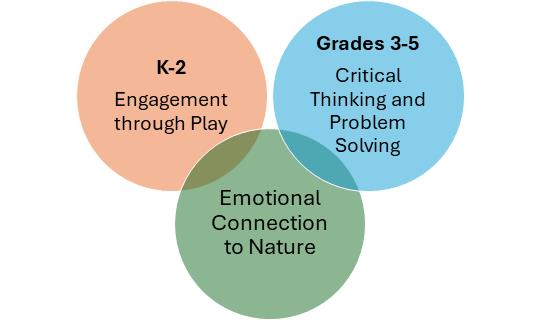Whether you’re guiding students in the classroom or encouraging exploration at home, introducing K-5 learners to natural resource education helps them develop essential skills like critical thinking, environmental stewardship, and scientific inquiry.
Through hands-on outdoor learning, children connect with nature in ways that foster curiosity, creativity, and a lasting sense of responsibility for the world around them. Explore our resources to create meaningful, engaging experiences that make a lasting impact.
Understanding K-5 developmental stages in outdoor learning

For younger children, hands-on activities and games spark curiosity and encourage outdoor exploration, while older children thrive on problem-solving and critical thinking challenges. Across all ages, creating shared outdoor experiences fosters emotional connections to nature and highlights the value of natural resources.
Learning stages
K-2: Sensory exploration and play-based learning
Children in kindergarten through 2nd grade thrive when learning is hands-on, sensory-rich, and driven by play. At this developmental stage, they benefit from activities that stimulate their curiosity and allow them to explore the natural world in a tactile way. Forest education and outdoor learning can be especially impactful, fostering early environmental awareness and respect for nature.
Age-appropriate activities include:
- Nature walks: Encourage children to explore the shapes, colors, sights, sounds, and textures of the forest, asking them to engage with their senses and observe natural objects like leaves, bark, and soil.
- Leaf rubbings: Introduce the concept of plant structures by having students create leaf rubbings, discussing the shapes and textures they observe.
- Storytime in nature: Combine literacy with nature by reading nature-themed books or telling stories while sitting near trees, promoting comfort and ease in outdoor settings. View our reading list of recommended books.
- Forest benefits wheel: This activity teaches children the importance of healthy forests by crafting a spinning wheel and using it to analyze forest benefits.
3-5: Critical thinking and problem-solving
Students in 3rd through 5th grade are developing critical thinking and problem-solving skills. At this stage, forest education can deepen their understanding of environmental issues and human impacts on nature. Through structured outdoor activities, students can explore key concepts like:
Topics and themes include:
- Tree growth, structure, and function: Studying the role of tree parts in ecosystem health through activities like measuring growth and identifying species.
- Tree Trails Elementary Curriculum & Learning App Ecosystem exploration: Investigating interactions between living and non-living components, such as soil, water cycles, and competition for resources.
- Stewardship and STEM skills: Engaging in hands-on tasks like tree planting, seed starting, forest products and forest restoration, fostering a sense of responsibility and sustainability.
Best practices for teaching outdoors
Safety and classroom management outdoors
NAAEE Practical Tips for Teaching Effectively Outside